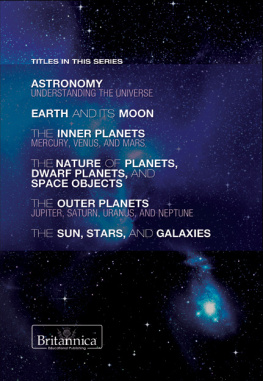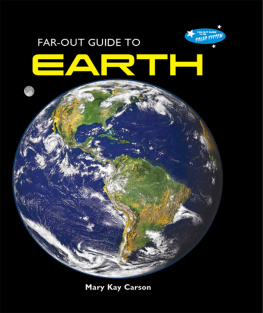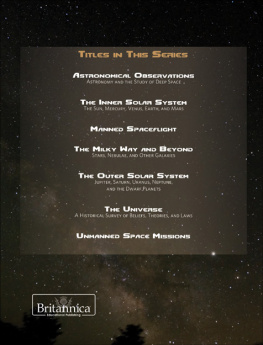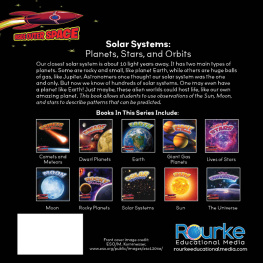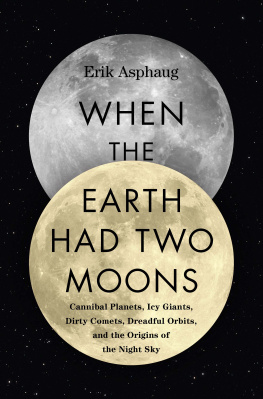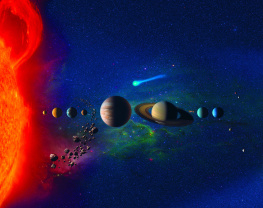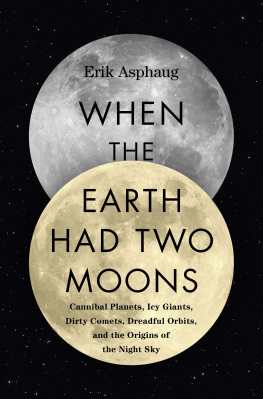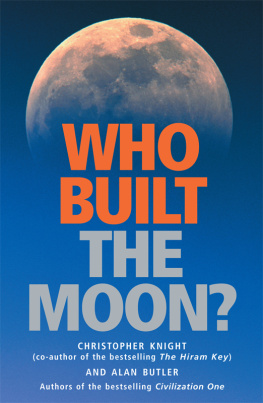EARTH AND ITS MOON
the solar system
EARTH AND ITS MOON
Edited by Michael Anderson

Published in 2012 by Britannica Educational Publishing
(a trademark of Encyclopdia Britannica, Inc.)
in association with Rosen Educational Services, LLC
29 East 21st Street, New York, NY 10010.
Copyright 2012 Encyclopdia Britannica, Inc. Britannica, Encyclopdia Britannica, and the Thistle logo are registered trademarks of Encyclopdia Britannica, Inc. All rights reserved.
Rosen Educational Services materials copyright 2012 Rosen Educational Services, LLC.
All rights reserved.
Distributed exclusively by Rosen Educational Services.
For a listing of additional Britannica Educational Publishing titles, call toll free (800) 237-9932.
First Edition
Britannica Educational Publishing
Michael I. Levy: Executive Editor, Encyclopdia Britannica
J.E. Luebering: Director, Core Reference Group, Encyclopdia Britannica
Adam Augustyn: Assistant Manager, Encyclopdia Britannica
Anthony L. Green: Editor, Comptons by Britannica
Michael Anderson: Senior Editor, Comptons by Britannica
Sherman Hollar: Associate Editor, Comptons by Britannica
Marilyn L. Barton: Senior Coordinator, Production Control
Steven Bosco: Director, Editorial Technologies
Lisa S. Braucher: Senior Producer and Data Editor
Yvette Charboneau: Senior Copy Editor
Kathy Nakamura: Manager, Media Acquisition
Rosen Educational Services
Jeanne Nagle: Senior Editor
Nelson S: Art Director
Cindy Reiman: Photography Manager
Matthew Cauli: Designer, Cover Design
Introduction by Jeanne Nagle
Library of Congress Cataloging-in-Publication Data
Earth and its moon / edited by Michael Anderson.
p. cm.(The solar system)
In association with Britannica Educational Publishing, Rosen Educational Services.
Includes bibliographical references and index.
ISBN 978-1-61530-564-3 (eBook)
1. EarthJuvenile literature. 2. MoonJuvenile literature. I. Anderson, Michael, 1972
QB631.4.E28 2012
525dc22
2011002175
Cover, back cover, pp, www.istockphoto.com/photovideostock; remaining interior background image www.istockphoto.com/BrooksElliott
CONTENTS






introduction

L ong ago, Earth was the subject of great speculation. Ancient astronomers such as Ptolemy thought that Earth was the center of the universe. Likewise, there have been all sorts of assumptions about Earths satellite, the Moon. One of the most interesting beliefs was that moonlight was capable of driving a person crazy.
Using a telescope, Galileo Galilei went on to show that the Sun was actually the center of the universe. And while some folks still believe that a full Moon brings out the weird in people, they have plenty of solid evidence that proves the Moon has real natural effects on Earth. For instance, the gravitational pull of the Moon during its many phases influences ocean tides. Many additional facts about Earth and the Moon have been discovered over the years. The results of years of research into the nature of Earth and the Moon are the subject of this book.
More is known about Earth than any other planet in the solar system, mainly because scientists have had the advantage of living here. Even before the advent of helpful technology such as the telescope and computers, scientists managed to find ways to figure out certain characteristics of the planet. These included its size, shape, and movement. For instance, ancient Egyptians measured shadow length and factored in the distance between cities to obtain a rough estimate of Earths circumference.
To find out about Earths physical structure, scientists test and observe the planets surface layer, known as the crust. Using material from this and the top of the next deepest layer, the mantle, they can work out formulas that tell them whats happening all the way down to Earths center, the core. To study the atmospherethe envelope of gases surrounding Earthscientists have an array of other techniques and tools, including radar and tethered balloons that carry sophisticated instruments.
Manned space missions have provided scientists with plenty of information about the Moons physical characteristics. Testing of Moon rocks revealed the age and composition of the satellites surface. Long before the rocket age, ancient astronomers used math, observation, and simple deduction to guesstimate measurements of the Moons size and its distance from Earth.
Exploration, observation, and experimentation have answered many questions, and dispelled many myths, concerning Earth and its satellite. Yet there are still many mysteries to be solved regarding this ever-evolving planet and its moon.
chapter 1
PLANET EARTH

T he third planet from the Sun is Earth, the home of all known life. While it shares many characteristics with other planets, its physical properties and history allow it to support life in its near-surface environment. Liquid water, which is essential for all known forms of life, is found in abundance on Earth. Deep, salty oceans cover more than two thirds of the surface.
In addition, Earths oxygen-rich atmosphere is unique. This characteristic is actually not surprising, however, since large amounts of oxygen exist in the atmosphere only because living things constantly supply it. Earths green plants take in carbon dioxide and give off oxygen, which humans and other animals need to breathe. This is one example of how life itself has altered the planet in ways that generally help maintain the conditions for life. Scientists have come to view Earth as a dynamic world with many interacting systems. Understanding these relationships will surely be important as human activities increasingly affect the planets surface, oceans, and atmosphere.
SHAPE AND SIZE
Many ancient cultures, even sophisticated ones such as the Egyptians, pictured Earth as being flat, with the sky above being a separate abode of heavenly bodies: the Sun, Moon, planets, and stars. By 2500 BC, though, some people correctly thought Earth to be roughly spherical in shape. The Greek mathematician Pythagoras is widely credited with reaching this conclusion in the 6th century BC. Two centuries later, Aristotle gave specific reasons for thinking Earth is round: (1) matter is drawn to Earths center and would naturally compress it into a spherical shape, (2) traveling south reveals new stars rising above the southern horizon, and (3) Earths shadow on the Moon at lunar eclipses is circular.
Next page
